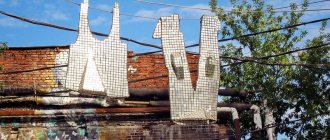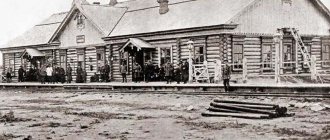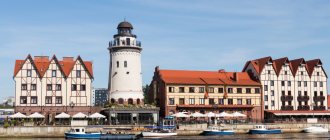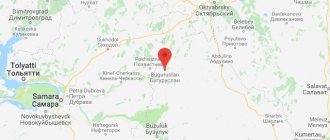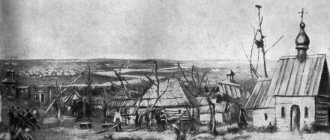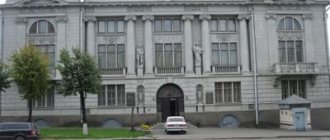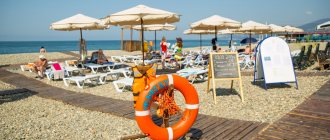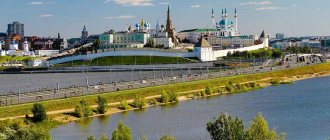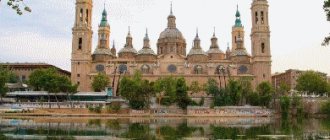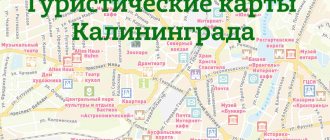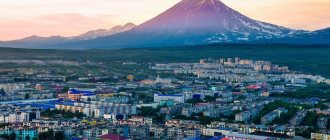- Moscow
- Saint Petersburg
- Gold and Silver Ring
- Sochi and Krasnaya Polyana
- Crimea
- Kaliningrad and region
- Lake Baikal
- Valley of Geysers in Kamchatka
Russia is the largest country in the world by area, and there are so many attractions in it that even the Russians themselves are not aware of most of them. But the main thing is all the more clearly visible: in the far West there are the sandy beaches of the Baltic, in the Far East there are the volcanoes and geysers of Kamchatka. The North is the Arctic, for the desperate. The south is the long-loved resorts of the Black Sea, and in the heart of the country there are two capitals and two rings of the most charming provincial cities, Zolotoye and Serebryanoe.
Moscow
Moscow begins with Red Square and the Kremlin. You can already linger here for a long time: see the cathedrals, visit the Armory Chamber and the Diamond Fund, go to the Lenin Mausoleum, and do some shopping at GUM.
Within walking distance are the Bolshoi Theater, the Cathedral of Christ the Savior, the recently renovated Gorky Park, and the Tretyakov Gallery with masterpieces of Russian painting. You can also walk to the Museum of Fine Arts. A. S. Pushkin on Prechistenka. But you will need to go to the popular Darwin Museum, and preferably by metro: this is an independent attraction of Moscow. Tourists love to photograph the mosaics, paintings and sculptures of the central stations.
You can take a break from the bustle of the city in the capital's parks. In the former royal residences, Kolomenskoye and Tsaritsyn, it is good to walk in nature and admire palaces and temples. A magnificent panorama of Moscow opens from the Sparrow Hills. The walls and towers of the Novodevichy Convent are especially beautiful when illuminated at night.
The Soviet era in Moscow is reminiscent of Stalin's high-rise buildings, the VDNH park with the "Friendship of Peoples" fountain, the "Conquerors of Space" stele with the Museum of Cosmonautics and the monument "Worker and Collective Farm Woman", on the pedestal of which an exhibition center is now open.
The Moscow region represents a separate world. It is famous for its noble estates, health resorts and a scattering of small towns, many of which deserve a separate trip.
Where to go outdoors in Russia: Altai Republic
The Altai Republic is one of the best options for where to go outdoors in Russia in any season. In winter they go skiing here, and in summer they go trekking.
Altai is undoubtedly included in the list of the most beautiful regions of Russia: local mountain landscapes and ribbon forests speak for themselves
In Altai there are routes for both beginners and experienced hikers. Ambitious climbers conquer the mystical Belukha, but the trek to Lake Akkem does not require any special preparation: you will enjoy the views on horseback and on foot and count the stars over a cup of aromatic tea from Altai herbs.
Another impressive place to explore is the Katunsky Nature Reserve with its magnificent Multinsky Lakes. To access these areas you will need permits, but the views are worth it.
Find tickets to Gorno-Altaisk
Saint Petersburg
“No matter the house, it’s a monument” - this is what they usually say about St. Petersburg. Its main attractions include the State Hermitage, the Peter and Paul Fortress, the Admiralty, St. Isaac's Cathedral, and the architectural masterpieces of Nevsky Prospekt.
This is not only a city-museum, it is also a city of museums: Russian, Marine, Artillery, Zoological. A city of bridges, especially drawbridges. Unusual monuments - Chizhik-Pyzhik, Mumu, the nose of Major Kovalev from Gogol's story.
St. Petersburg is surrounded by a ring of world-famous suburbs: Peterhof with its fountains, Pushkin with the Amber Room in the Catherine Palace, Lomonosov with the Oranienbaum palace and park ensemble. Fans of military history will discover fortresses and forts: Koporye, Shlisselburg, Vyborg Castle, Kronstadt.
From St. Petersburg you can go on a cruise to the wooden churches in Kizhi or to the historical monastery of Valaam Island.
Museums of Russia
Hermitage
The State Hermitage Museum is located on Palace Square in St. Petersburg. 5 mansions in the Baroque style house historical values of world significance. Guests can see works of art from different eras, collections of antique statues, bas-reliefs, and objects reflecting the cultural characteristics of Asia and Europe.
In the Winter Palace, which is part of the Hermitage, you can explore the royal royal apartments and the magnificent decoration of the halls. Alas, to get acquainted with each exhibit of the museum, you will need to spend at least 8 years.
Tretyakov Gallery
The Moscow Tretyakov Gallery houses the largest collection of Russian painting from the 11th to early 20th centuries. Here you can see paintings by Viktor Vasnetsov, Ivan Shishkin, Valentin Serov, Ilya Repin, Nicholas Roerich, Vasily Surikov, Karl Bryullov. The gallery also stores icons, sculptures, and graphics.
Permanent and temporary exhibitions introduce the best works of art from different eras and movements.
Faberge Museum
A private Faberge museum has been opened in the Naryshkin-Shuvalov Palace in St. Petersburg. It consists of 11 halls in which 4 thousand unique items are exhibited. The crown jewel of the collection are the imperial Easter eggs created by the firm of Carl Gustav Faberge.
Guests are shown silverware, jewelry, and Russian icons. In the museum halls there are paintings by Renoir, I. Aivazovsky, K. Bryullov, K. Korovin.
Diamond fund
There is a permanent exhibition of the Russian Diamond Fund in the Moscow Kremlin. The collection represents state regalia, jewelry and orders. The pride of the Russian treasury is considered to be precious stones with a rich history: the Shah and Orlov diamonds, giant emeralds, sapphires and semi-precious stones.
Visitors to the museum have the opportunity to see the family jewelry of the royal family, a map of the country lined with diamonds and imperial crowns.
READ ALSO
30 best sights in Kyiv
Armouries
The Armory Chamber is located on the territory of the Moscow Kremlin. By decree of Emperor Alexander I, a museum was created in it, which collected numerous valuables from the 4th to 20th centuries. The collection is based on gifts made to the emperor by ambassadors of other countries, objects of decorative and applied art, and archival documents. Popular exhibits include Monomakh's hat, royal carriages, Faberge eggs and coronation costumes.
Pereslavl-Zalessky Museum-Reserve
In Pereslavl there is a historical and architectural museum, opened in the Dormition Goritsky Monastery in 1918. It preserves ancient Russian icons, wooden sculptures, antique furniture, church utensils, and items of noble and peasant life.
The museum administration offers excursions designed for different age categories. Guests can take part in entertainment programs, theatrical historical performances and visit branches within the city: the Transfiguration Cathedral, the Ganshin Estate Museum or the Boat of Peter I.
Kunstkamera
in St. Petersburg there is a “cabinet of curiosities”, opened by order of Peter I. Now it is a museum of anthropology and ethnography, which includes museum halls, a library, an anatomical theater and an astronomical observatory. Tourists are shown a collection of preserved freaks, skeletons of Siamese twins and people with physical disabilities.
The Kunstkamera hosts permanent ethnographic exhibitions telling about the cultural characteristics of the Japanese, Eskimos, Africans, Chinese, Indonesians and Native Americans.
Amber Museum in Kaliningrad
Kaliningrad is famous for the largest amber deposit in the world. The museum, established in 1979, is located in a spacious three-story building. The natural science exhibition presents amber samples of various shapes and sizes.
In many exhibits it is easy to detect parts of plants or insects that got there millions of years ago. The cultural and historical department is designed to display ancient and modern amber objects.
Stalin's bunker
At the beginning of the Great Patriotic War, construction of a bunker for Joseph Stalin began in Samara under conditions of strict secrecy. In 1990, the bomb shelter was declassified and a museum was opened on its territory. There is the leader's office, a meeting room, and rest rooms. The Soviet interior from the forties has been preserved inside. The underground structure goes 37 meters deep - there are stairs and an elevator to descend.
Experimentanium
The interactive museum in Moscow was created for everyone to study science. You are allowed to interact with the exhibits, that is, touch them with your hands, turn them on and off. Adults and children can watch installations that explain why sea waves appear, how electric current is generated and a space rocket is built.
Visitors also have the opportunity to independently conduct chemical and physical experiments, compete with each other in solving puzzles, and admire optical illusions.
Gold and Silver Ring
In addition to Moscow and St. Petersburg, there are cities in Russia that claim to be the “third capital”. Usually this title is given to the capital of the Urals, Yekaterinburg, which is famous for the huge Church on the Blood, built on the site of the execution of Emperor Nicholas II and his family.
In recent years, Ekaterinburg has gained a rival - Kazan, the heart of the Republic of Tatarstan. People come here to see the Kazan Kremlin, where ancient Orthodox cathedrals coexist peacefully with the recently built Kul-Sharif mosque. One of the symbols of the Kremlin is the leaning tower of Syuyumbike: it is 2 meters higher than the Leaning Tower of Pisa.
The charm of deep, provincial Russia is revealed in excursions around the Golden Ring, which includes Vladimir and Kostroma, Suzdal and Pereslavl-Zalessky, Sergiev Posad and Yaroslavl, Rostov Veliky and Ivanovo. There is also the Silver Ring - fortified cities located within the borders of the ancient Novgorod land, led by Veliky Novgorod itself.
The most interesting regions of Russia: Moscow region
You get the feeling that a real Hogwarts Express is running from Moscow, taking you straight to a parallel magical world. The contrast is so impressive after a huge, noisy city, when a couple of hours on the train transports you to the ancient Russian flavor with cozy churches or the kingdom of untouched nature where bison roam.
For peace, head to Sergiev Posad, the closest Golden Ring city to the capital. People come here to visit the Holy Trinity Lavra of St. Sergius and other beautiful temples, churches and chapels that this ancient city is rich in.
A couple of hours drive from the Moscow City skyscrapers - and before you come to life paintings by Russian painters
The estates of the Moscow region can also be explored endlessly. Here you have Abramtsevo, where Serov wrote the famous “Girl with Peaches”, and Muranovo, where the Boratynskys and Tyutchevs lived, and even “Guslitsa”, where a co-working, co-living and cultural and educational center have now been opened.
You finally become immersed in the magic of the Moscow region on the eco-trails of the Prioksko-Terrasny Nature Reserve. Bison and bison rule here, and guests watch the furry peers of mammoths from observation platforms. And to breathe fresh air in solitude, go to the lake or into the forest: you can go for a picnic or stay in a wonderful glamping camp.
For dessert - romantic Kolomna with its atmospheric trams, carved frames and Russian delicacies according to ancient recipes.
Choose a hotel in the Moscow region
Sochi and Krasnaya Polyana
Sochi is called the summer capital of Russia. It became a resort back in 1909, with the opening of the Caucasian Riviera sanatorium complex, the most comfortable in Tsarist Russia. Today, the beaches of the Sochi region stretch for 114 km and attract vacationers with the warm sea, fresh mountain air and entertainment for every taste.
After the 2014 Winter Games, a huge Olympic Park and a new resort area, Imeretinsky, were added to them, which arose on the site of the former Olympic Village. If previously people traveled to Sochi and its suburbs mainly in the summer, the Olympics made it an all-season destination.
Just 39 km from the city is the village of Krasnaya Polyana. A variety of slopes, modern ski lifts and developed infrastructure, completely modernized for the Olympics, have brought the resort to a new level. Now it can also be called the winter resort capital of Russia.
Crimea
The peninsula is usually divided into three shores: Western, Southern and Southeastern. The first and last ones are more interesting for a beach holiday, and the main attractions and the most famous resort towns are located in the South Coast. It is worth seeing at least the Livadia Palace, the summer residence of the Russian emperors near Yalta, and Vorontsov Park in Alupka.
If the excursion takes you to the Massandra wine estate, founded at the end of the 19th century by the Golitsyn princes, then you can also look into the Massandra Palace, similar to a French castle. Another castle-palace, the famous “Swallow’s Nest” on the top of a 40-meter cliff, is called the calling card of Crimea. It is also located in the vicinity of Yalta.
A cable car has been laid from ancient Miskhor to the top of Mount Ai-Petri, unique in that there are only 2 supports for its 2980 m length. This is a world record.
Literature lovers will find the house-museums of Chekhov, Voloshin, and Green on the South Bank. Art connoisseurs will discover the country's largest collection of paintings by Aivazovsky, a native of Feodosia. And fans of military history will not pass by the “Defense of Sevastopol” panorama and the underground Cold War Museum in Balaklava, on a former submarine base.
In a fit of nostalgia, you can even go to the Artek children's camp, where all Soviet schoolchildren dreamed of going.
Kaliningrad and region
If St. Petersburg is considered a window to Europe, then the Kaliningrad region, historically and geographically, is Europe. The German spirit can still be felt in Kaliningrad with its cathedral, Kant's tomb, ancient city gates and bastions, one of which houses the only amber museum in Russia.
The beach suburbs are also cozy in a German way, especially Svetlogorsk: a hydropathic tower with a sundial, toy houses with tiled roofs scattered among the pine trees, a long promenade along the sea.
An even more relaxing beach holiday can be found on the Curonian Spit. This is a national park in the north in the Kaliningrad region. The sandy strip, from 400 m to 4 km wide, stretches for 98 km, from the Russian Zelenogradsk to the Lithuanian Klaipeda.
In the photos of attractions from this part of the country, the “Dancing Forest” takes pride of place - the intricately curved pines there seem to have frozen in a complex acrobatic dance.
Monuments and landmarks of Ancient Rome
The Eternal City is replete with numerous monuments related to the history of the city BC. When spending your holidays in Rome, you cannot miss them in your excursion plan. The Pantheon, Colosseum, Capitoline Hill and Roman Forum are just a few of the attractions that await visitors.
Pantheon
The best preserved monument of Ancient Rome is the Pantheon. The temple was built in the 1st century to honor the most important deities of Ancient Rome. The plan is made in the form of a circle, preceded by a portico column. The central part is crowned by a concrete dome with a diameter of more than 43 meters , which is a miracle of modern technology. At its top there is a hole with a diameter of 9 meters, which is the only source of natural light in the entire temple. Niches are carved into the walls, in which statues of ancient deities used to stand; today their place is taken by the graves of significant figures in the history of Italy - kings and masters of art .
Roman Coliseum
When visiting Ancient Rome, it is impossible to miss the Colosseum. The Flavian Amphitheater was built in the 1st century by Emperor Vespasian . At one time the building could accommodate as many as 70,000 spectators. The amphitheater hosted numerous performances, including bloody gladiatorial fights. The Colosseum also served as an arena for animal fighting, known as a venatio, as well as a site for religious performances. Although the splendor of the Flavian Amphitheater passed with an earthquake that contributed to significant damage and the spread of Christianity (until 1744 the Colosseum served Italy as a quarry), the ruins it left behind are still impressive. The accumulation of architectural orders is still noticeable, on individual floors there are columns of the Tuscan, Ionic and Corinthian orders, and at the very top there are Corinthian pilasters. The Colosseum is believed to be the site of the martyrdom of the early Christians , which has not been fully proven. However, inside the building there is a monstrous cross in memory of these terrible events.
Roman Forum - the oldest city square in Rome
Not only was the Colosseum destroyed by the earthquake and the gradual demolition of the city's inhabitants, for whom the ancient ruins were a source of easily accessible building materials . A similar fate befell the Roman Forum, which is the oldest city square in Rome. It was here that political, religious and social life flourished in ancient times. There are as many theories about how the Roman Forum was created as there are historians. However, the most popular theory is that in the 8th century BC the area of today's square was covered by a swamp . A drainage canal was built to drain them. It is not known exactly what the later history of this place was, but it is certain that the square was once bustling with life. Most of the buildings that were located here were destroyed or only rubble remained. The Temple of Venus and Roma is in relatively good condition. The sanctuary, built by the Corinthian order, is located on a concrete platform and its concrete walls are lined on the outside with white marble . Inside the temple there were two cells, one dedicated to the cult of Venus, and the other to the gypsies. Another architectural object whose remains you can admire is the Basilica of Constantine and Maxentius. It is the largest building in the entire Roman Forum with a vaulted ceiling. Its walls and floor are lined with amazing colorful marble that delights visitors.
Capitol
The seven hills surrounding Rome, including the Capitoline Hill, are visible from the Roman Forum. Most of the ancient buildings burned down in the great fire of Rome . In modern times, the square was rebuilt in accordance with Michelangelo's idea, and in the following centuries, representative buildings were erected on it, which today proudly tower over the entire city. Also worth mentioning is the statue of Marcus Aurelius, which was installed in front of the Senatorial Palace. However, in addition to the beautiful historical monuments, the Capitol is worth a visit mainly because of the phenomenal panorama of the entire city . It is an unearthly sight, especially in the evening when the starlight reflects on the roofs of the majestic temples and basilicas, casting twinkling lights everywhere.
Lake Baikal
“A person must build a house, plant a tree, raise a child.” In Russia, some people add one more item to this list: go to Lake Baikal. This is the deepest lake on the planet and the largest natural reservoir of fresh water: almost 20% of all its global reserves. But it’s not the numbers that attract people here, but the lake itself, its mystical power and beauty. No wonder the main symbol of Baikal is the Shaman Rock with two peaks on the Olkhon Peninsula.
Not far from the lake shores is the main Buddhist temple of Siberia: this is the Ivolginsky datsan with the incorrupt body of a lama. And the Circum-Baikal Railway, 90 km long, is the absolute champion of Russia in terms of the number of bridges, viaducts, galleries and tunnels.
Traveling around Russia in questions and answers
Is it possible to travel around Russia now? In general, traveling around Russia is possible. We recommend following safety precautions and checking local government regulations before traveling.
Where should you go in Russia? There are many wonderful places in Russia for every taste. For inspiration, look at a selection of the most atmospheric towns and villages in the country, a list of comfortable places to relax at home, and unusual winter travel ideas. And also admire the most beautiful lakes and mountains of Russia and find out where to get acquainted with folk crafts.
How interesting is it to spend a vacation in Russia? In the vastness of Russia, it’s easy to arrange a colorful trip close to home. Take a closer look at cool mineral and bath resorts, picturesque nature reserves, truly unique hotels and beautiful hotels in the mountains.
Valley of Geysers in Kamchatka
This is the only geyser field in Eurasia and one of the five largest geothermal areas on the planet. It is difficult to get here; tourists can get to the Valley of Geysers only as part of a tour or in agreement with the administration of the reserve.
The valley is a gorge 8 km long. The Geysernaya River flows along its bottom, and geysers stretch along its bed. The most important of them, the Giant, erupts every 5 - 7 hours, throwing jets of boiling water to the height of a nine-story building.
Top 10 natural attractions in the world
Sights of the world, photos with names of which can be found in various publications, are visited by millions of tourists every year.
The ten most famous and visited natural attractions include:
| Name of attraction | Object location |
| Monument Valley | USA |
| Marble Cave | Chile, Argentina |
| Jiuzhaigou National Park | China, Sichuan Province |
| Blue hole | Belize |
| Pamukkale | Türkiye |
| Blue Lagoon | Iceland, Reykjanes Peninsula |
| Waitomo Glowworm Caves | New Zealand |
| White Harbor | Australia |
| Vatnajökull Ice Caves | Iceland |
| Colored rocks of Zhangye Danxia | China, Gansu Province |
Sights of the world, photos with names of which are available on the Internet, attract many extreme sports enthusiasts.
Monument Valley
Monument Valley is located on the border of 2 states: Utah and Arizona. It is a plain on which there are unusually shaped rocks. This territory belongs to the Navajo Indian tribe, whose representatives conduct tours and have rights to Monument Valley.
Many millions of years ago there were mountains on the plateau. But gradually they were exposed to wind and other natural phenomena and were destroyed. Those rocks and monuments that have survived to this day are also subject to change.
We will look at the top 20 attractions in the world. And the first of them is Monument Valley.
Each object in Monument Valley has its own name. Movies about cowboys are often shot in this valley.
Marble Cave
Nature itself created the beauty of marble caves. They belong to the territory of Chile and Argentina and are located on a peninsula near the city of Chile Chico. The blue-blue rocks together with the clear water of the lake create a paradise. The caves contain many labyrinths and tunnels that were formed by waves.
Many years ago the caves were hidden by a glacier. And when it melted, people were able to observe one of the most beautiful places on Earth. Marble Caves are the largest deposits of marble in the world.
Jiuzhaigou National Park
The national park is a picturesque place with beautiful waterfalls and colorful lakes. Jiuzhaigou means the settlement of 9 villages. And in fact, there are 9 Tibetan towns in the valley, 7 of which are inhabited by people.
There are many plant species growing in the park. Some of them live only here. You can also find rare species of animals. There are 108 beautiful lakes in the valley, each of which is different from the others. In the park you can find a lake that has 5 colors (blue, green, yellow, purple and silver). This feature is given to it by algae in the water.
Blue hole
The Blue Hole is located in the center of Lighthouse Reef Atoll. It is a cave going deep. The Blue Hole is a favorite place for extreme divers. The diameter of the cave is about 300 m. The depth of the hole reaches 120 m.
When choosing an excursion, you need to take into account the ebb and flow of the tides. During high tides, sinkholes can form that suck in not only divers, but also boats. During low tides, water and debris are thrown out of the hole in a fountain. The Blue Hole is favored by some species of sharks.
Pamukkale
Geothermal springs in Pamukkale are located near the city of Denizli. The water temperature in the springs reaches 36 degrees. On an area of more than 1 hectare there are 17 natural swimming pools with mineral water. Due to the high calcium content in the water, a white sediment has formed on the surface of the springs and plain over the years.
The thermal springs in Pamukkale not only offer stunning scenery, but also help relax the body and are excellent for the skin and joints. Pamukkale can be seen in the movie Ghost Rider 2.
Blue Lagoon
Another thermal spring, the Blue Lagoon, created by nature, is located in Iceland near the city of Grindavik. The thermal pool is located in the depressions of hardened lava over an area of about 2 km. It is 200 m wide.
A SPA center was built on the site of the springs. The water temperature in it stays around +37 - +40 degrees even in winter. The water in the source comes from a thermal power plant and this happens every 2 days. There is white clay at the bottom of the pool. The source is completely free of various microorganisms due to the high concentration of silicon, which makes the water clean.
The water in the thermal pool is good for the skin. The Blue Lagoon is recognized as the world's best spa resort.
Waitomo Glowworm Caves
The Waitomo Glowworm Caves are a magical place created by nature itself. The limestone caves were formed by the action of the ocean. They contain a large number of passages and tunnels. The caves have good acoustics.
On Christmas night, works are performed there acapella. But the main highlight of the caves are the fireflies living in them. They glow azure blue and create the effect of a starry sky.
In the Waitomo Caves you can also see stalactites (icicles hanging from the ceiling of the cave) and stalagmites (formations located at the bottom). The caves are actively used for rafting, which attracts a large number of extreme sports enthusiasts.
White Harbor
The beaches of White Harbor in Australia are located in the Holy Trinity Archipelago. They are distinguished by crystal clear white sand that resembles snow. The white color of sand is due to the high silicon content in it. It never gets hot on hot days.
White Harbor is a nature reserve, so there are no establishments or hotels on the island. The beaches are perfect for lovers of wild holidays. White beaches and clear turquoise water are a real paradise. These places are suitable for fans of active recreation. For those who like silence, you can simply sit on the sand enjoying the views, or swim.
Vatnajökull Ice Caves
Another natural beauty is found in Iceland. The Vatnajökull glacier is the largest in Europe. It occupies almost 8% of the entire island. Caves and tunnels in the glacier were formed under the influence of melt water. Some of them appeared as a result of exposure to thermal springs. Many tunnels reach a length of 300 m.
As a result of all the processes occurring in the glacier, the ice turns into unusual shapes. The ice caves are reminiscent of the kingdom of the Snow Queen. They attract tourists with their shimmering colors: from yellow to aquamarine.
Colored rocks of Zhangye Danxia
The colorful rocks are part of a national reserve and are located 30 km from Zhangye. Rocks appeared as a result of the movement of lithospheric plates. They became colorful thanks to deposits of red sandstone and other natural minerals. Under the influence of wind over many years, the rocks have acquired interesting shapes.
The colorful rocks look best during sunset. Many tourists visit the attraction to personally see the miracle created by nature.
